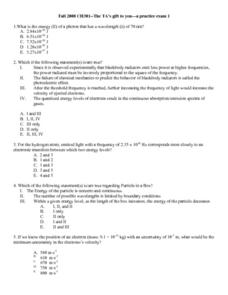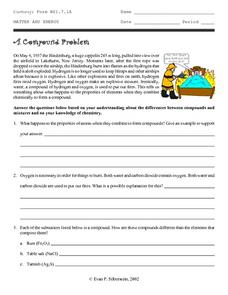Curated OER
Elements
In this elements worksheet, students write the electron configurations for given elements. Students describe ionization energy and electron affinity and the periodic trends for both. This worksheet has 20 short answer questions.
Curated OER
Chemistry 301
In this chemistry 301 instructional activity, students answer questions as it relates to the electron configuration of given elements. Students use the periodic table to assist in their interpretation of the questions provided.
Balanced Assessment
Solar Elements
Let your brilliance shine like the sun. Future mathematicians and scientists consider given data on the abundance of different elements in the sun. The assessment task requires consideration of how these different abundances relate to...
Curated OER
Predicting and Naming Polyatomic Ionic Compounds Worksheet
In this compounds worksheet, learners write the polyatomic ionic compound formulas or the compound names. This worksheet has 29 problems to solve.
Curated OER
Working Out Empirical Formulae
In this chemical compounds worksheet, students learn the steps for determining the empirical formula of a compound and then complete 3 problems.
Curated OER
A Compound Problem
In this compounds worksheet, learners compare the differences between compounds and mixtures. This worksheet has 3 short answer questions.
Curated OER
Acids and Bases
In this acids and bases worksheet, students will identify the molecules represented in a diagram equation and determine if an acidic or basic solution has been produced. Students will list the properties of acidic and basic solutions....
Curated OER
Lesson- Radial Solution, Hydroggen Wavefunction
Student uses Schrodinger's equation applied to a single electron Hydrogen atom. They use angular and radial portions equation to answer questions. Student use a model to answer equation questions.
Curated OER
Nuclear Power
In this nuclear power worksheet, students read how atoms can be changes and are unstable. Students compare 3 kinds of radiation and the difference between fission and fusion. Then students complete 10 matching and 2 short answer questions.
Curated OER
Nuclear Fusion
For this nuclear fusion worksheet, students look at the energy released when nuclear fusion occurs. Students determine how scientists are trying to harness fusion to produce electricity. This worksheet has 3 fill in the blank and 9 short...
Science Geek
The Mole
What can you call a tooth in a glass of water? A one-molar solution! Presentation covers moles, Avogadro's Number, calculating formula mass, converting moles to grams, converting grams to moles, and calculations with moles. It is...
National Institute of Open Schooling
Chemical Bonding
Name is Bond, covalent bond. Through readings and answering questions, classes explore the different types of chemical bonds, their characteristics, valence shell electron pair repulsion theory, and atomic orbitals.
SRI International
Science of Water
Water is crucial to survival. Scholars gain an appreciation for water by reading about it, learning about its atomic properties, and investigating its properties through six stations in a lab activity.
Royal Society of Chemistry
Electronegativity Values
Finally, an electronegativity resource your class will be strangely drawn to! Skilled scientists manipulate interactive puzzles to gain an understanding of common electronegativity values. The great thing? You can conduct the lesson...
Curated OER
Extracting Oxygen from Moon Rocks
In this extracting oxygen from moon rocks worksheet, learners read about the need for oxygen for lunar colonists. Students solve 2 problems about the lunar mineral ilmenite which contains oxygen and other elements. They find the molar...
Curated OER
Bonding Basics Review
In this bonding activity, students complete a chart of elements, their symbols, the total number of electrons, the number of valence electrons and the oxidation numbers. They draw Lewis structures for atoms and show the transfer of...
Curated OER
The Moon's Atmosphere
In this moon's atmosphere instructional activity, students read about the tenuous lunar atmosphere and solve 4 problems. They find the density of helium particles, they find the grams of given atoms in the moon's atmosphere and they find...
Curated OER
The Bohr Model vs. the Wave Mechanical Model
In this Bohr model and wave mechanical model worksheet, students read about the differences between these two models of the atom. Students answer four questions about these models.
Curated OER
Periods and Groups; Valence Electrons; Masses
In this periods, groups, valence electrons and masses worksheet, students are given information about all these components of the periodic table. Students identify 4 elements in specific periods and groups, they find the valence...
Curated OER
Oxidation/Reduction Reactions
In this chemical reactions learning exercise, learners review the oxidation number rules and then assign oxidation numbers to atoms in given compounds. Students identify the reducing agent and the oxidizing agent in reactions. Learners...
Curated OER
Periodic Table
High schoolers investigate the structure and development of the periodic table. In this periodic table lesson plan, students are given colored strips of paper that represent different atoms. They classify the atoms based on the paper's...
Curated OER
Metals vs. Non-Metals: Dot Diagrams; Ions
In this metals, non-metals, dot diagrams and ions learning exercise, high schoolers read about each of these topics and they identify if 8 elements are metals or non-metals, they draw electron dot diagrams for 5 elements, they write the...
Creative Chemistry
Working out the Shapes of Molecules
For this molecular geometry worksheet, learners are given directions and four examples for predicting the geometry of molecules. They determine whether the molecules are pyramidal or trigonal bipyramidal.
Curated OER
Models of Hydrocarbons
High schoolers construct models of hydrocarbon molecules using candy and toothpicks. In this hydrocarbons lesson plan, students are given a sheet with the molecular formulas of hydrocarbons. As a group, they construct each molecule using...

























